 |
 |
 |
| |
Hepatitis C Viral Kinetics During Treatment With Weekly Versus Twice Weekly Peg IFN-alpha-2a in HIV/HCV Co-infected Patients
|
| |
| |
Reported by Jules Levin
4th IAS Conference, July 2007, Sydney, Australia
1Murphy AA, 1Polis MA, 1Sachau W, 1Gille C, 3O' Shea MA, 1McConnell R, 1Rehm CA, 2Proschan M, 1Koratich C,
3Masur H, and 1Kottilil S.
1LIR, NIAID, NIH, DHHS, Bethesda MD 20892, 2BRB, NIAID, NIH, Bethesda, MD 20892, 3CCMD, CC, NIH, DHHS.
Bethesda, MD 20892
AUTHOR CONCLUSIONS
Twice weekly Peg-IFN therapy for the first 4 weeks yields higher rate of early
virological response when compared to standard treatment. (Jules: the ETR response is so far not impressive, but the results are preliminary, not all patients have yet finished, and the study is small).
Twice weekly Peg-IFN treatment for the first 4 weeks is safe and is tolerated to the same extent as standard treatment. (Jules: neutropenia and anemia occurred more often in twice weekly group although it wasn't statistically significant, see graph below)
Twice weekly Peg-IFN treatment for the first 4 weeks is associated with rapid
normalization of hepatic enzymes.
Early HCV viral kinetics parameters such as Week 2 and Week 4's absolute HCV
viral load and 2nd phase viral decline are excellent predictors of viral response
irrespective of therapeutic regimen.
Combination of Week 2 viral load and Day 7 viral decline provide the best predictive values, with a PPV of 88% and a NPV of 100% for ETR.
Future studies are warranted to validate the clinical utility of using twice weekly
Peg-IFN treatment to improve SVR in HCV and HIV co-infected patients.
BACKGROUND
HCV/HIV co-infected patients have rapid progression of liver fibrosis and only modest cure rates (sustained virologic responses, SVR) when compared to HCV monoinfected patients. We compared the virologic responses to twice weekly peginterferon alpha- 2a (Peg-IFN) (for 4 weeks, followed by weekly dosing) plus ribavirin with weekly Peg- IFN plus ribavirin among HIV/HCV co-infected subjects.
METHODS
Ten HIV/HCV genotype 1 co-infected patients were treated with standard weekly
PEG-IFN (180ug sc qwk) and 9 received twice weekly Peg-IFN (180ug) for 4 weeks followed by weekly doses for a total of 48 weeks. Both groups received ribavirin (1-1.2g daily) for 48 weeks. Liver chemistry, HCV VL, HIV VL, and immunologic parameters were performed prior to and at frequent intervals during treatment. The Wilcoxon rank sum test was used to make comparisons.
RESULTS
All virological parameters were lower for patients receiving the investigational therapy. More patients on the investigational arm achieved clinically relevant early virological response (EVR) at week 2, 4, and 24. 1st and 2nd phase viral and week 2 and week 4 viral loads either alone or in combination were excellent predictors of viral response. Investigational regimen also resulted in a rapid normalization of liver enzymes and was equally well tolerated by patients.
CONCLUSIONS
Twice weekly Peg-IFN is associated with better early virologic response with similar safety profiles when compared with standard therapy. These improved early HCV kinetics may lead to improved SVR among HIV/HCV co-infected individuals. Our results, when confirmed in larger randomized clinical trials, may provide a novel therapeutic approach to improve SVR among HIV/HCV co-infected patients.
INTRODUCTION
Co-infection with chronic hepatitis C virus (HCV) is seen in one-third of all HIVinfected persons in the US due to shared routes of transmission as bloodborne pathogens (1, 2).
HCV/HIV co-infected patients have a rapid progression of liver fibrosis to cirrhosis when compared to that of HCV mono-infected individuals (3).
Moreover, co-infection with HIV decreases the rates of SVR to combination therapy (4, 5, 6).
Recent studies have suggested that early HCV viral kinetics can be used to predict virologic responses in HIV/HCV co-infected individuals (7).
These studies have suggested that twice weekly dosing of Peg-IFN would:
- Prevent end of week rebound
- Improve early viral respone
- Possibly increase SVR among HIV/HCV co-infected individuals.
In this study we treated HIV/HCV co-infected patients with either weekly or twice
weekly Peg IFN for the first 4 weeks, followed by once weekly treatment. Standard doses of ribavirin were used for both arms.
Study Design
This was a pilot, prospective, randomized controlled trial performed at the National Institute of Allergy and Infectious Diseases (NIAID), National Institutes of Health (NIH) at Bethesda, Maryland from 2004 to 2007.
Nineteen HIV/HCV genotype-1 co-infected patients were randomized to receive
either:
-- Peg-IFN at 180ug subcutaneously every week (Pegasys; Hoffman La-Roche Inc, Nutley, New Jersey, USA) and ribavirin daily (Copegus; Hoffman La- Roche Inc, Nutley, New Jersey, USA, at 400mg Qam and 600mg Qpm for
< 75kg, 600mg twice per day for > 75kg) for 48 weeks or
--Peg-IFN 180ug twice weekly for 4 weeks, followed by once weekly regimen
along with same dose of ribavirin for 48 weeks and
--followed up for 24 weeks after the end of treatment.
All patients signed informed consent approved by the NIAID institutional review
board prior to enrollment in the study.
Study Subjects
Patients were eligible for the study if they:
--Were > 18 years of age
--Had CD4+ T cell counts > 100 cells/mm3,
--Had absolute neutrophil counts >1000 cells/mm3,
--Had HCV viral load >2000 copies/mL,
--Had histologic evidence of chronic hepatitis C and
--Had stable HIV disease with or without ART.
The demographic characteristics of the two groups of patients studied are given
in Table 1 and 2.
Laboratory Studies
HCV and HIV RNA concentration in plasma were measured by VERSANT RNA 3.0 Assay (Bayer Diagnostics, Puteaux, France) during all study visits.
The assay has a lower limit of detection for HCV of 615 IU/mL.
HCV RNA concentration was measured in plasma on day 0, 3, 5, 6, 7, 10, 14, 21,
28, 42, 56 and then every 4 weeks for 72 weeks.
Liver chemistry and safety laboratory tests were performed prior to the treatment
and during each study visit.
Statistical Analysis
The non-parametric one-tailed t test was used to determine the differences in the
slope analysis. Wilcoxon rank sum test was used to determine absolute viral load
changes from baseline and Fischer's exact test was used to determine the differences between adverse events and ALT and AST changes between the two groups. Viral kinetics were determined as described before (7).
RESULTS
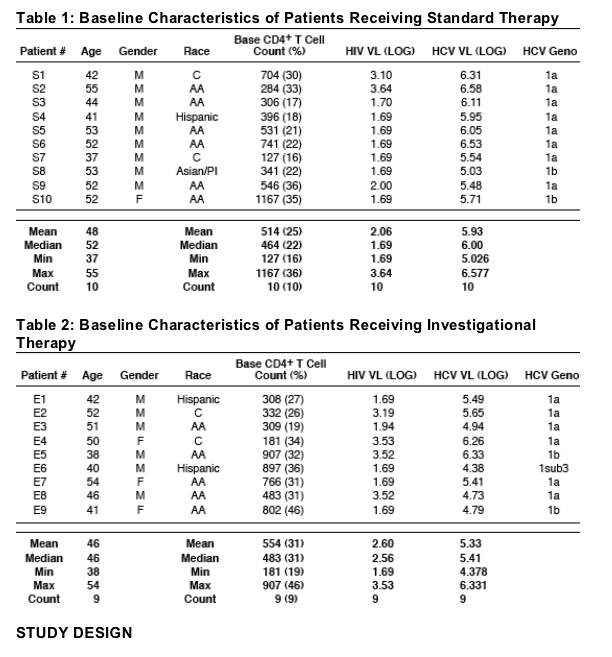
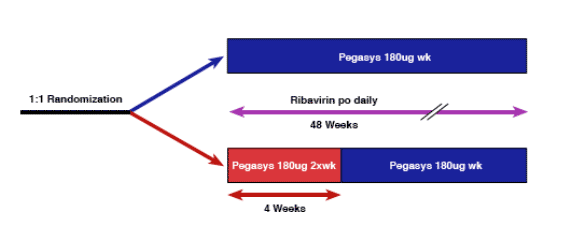
Figure 2: Virological Response to Standard vs. Investigational Therapy. In graph 2c you can see the difference between the 2 treatment groups for the end of treatment response is not very much apparently. The results are preliminary however as all patient's responses are not in yet so we need to see and wait for the full results.
(A) & (B) All virological parameters were lower for patients receiving the investigational therapy.
(C) More patients on the investigational arm achieved clinically relevant early virological response (EVR) at week 2, 4, and 24.
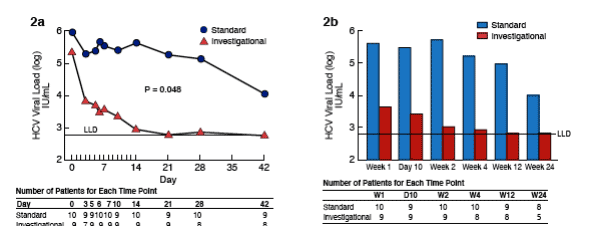
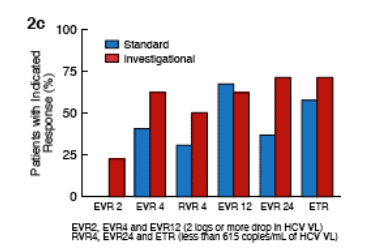
Figure 3: Viral Kinetics.
(A) Rapid first and second phase HCV viral kinetics were associated with better virological outcome irrespective of Peg-IFN dosage.
(B) Week 4 HCV viral load and 2nd phase viral decline (PPV 75%, NPV 86% for ETR).
(C) Week 2 HCV viral load and 2nd phase viral decline (PPV 88%, NPV 86% for ETR).
(D) Week 4 HCV viral load and Day 7 viral decline (PPV 88%, NPV 100% for ETR).
(E) Week 2 HCV viral load and Day 7 viral decline (PPV (88%, NPV 100% for ETR).
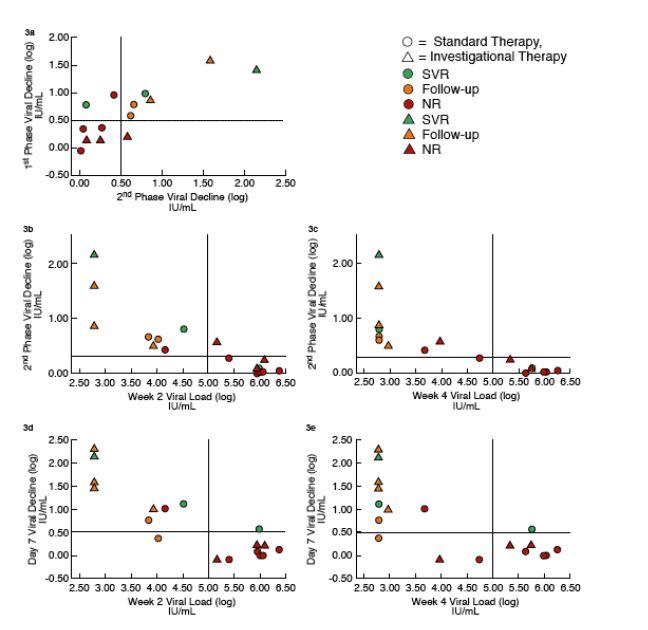
Figure 4: Biochemical Response- Normalization of Liver Enzymes.
Higher percentages of patients receiving investigational therapy achieved normalization of ALT and AST by Week 24 than patients receiving standard therapy.
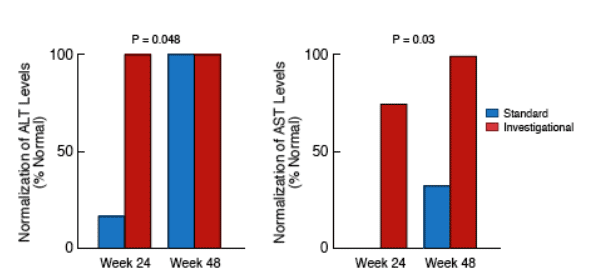
Figure 5: Adverse Events.
Note from Jules: neutropenia and anemia occurred more often in the twice weekly group, although the difference is not statistically significant (p>0.05); the numbers of study patients are small.
The adverse event profiles were similar for both groups. No statistically higher incidences of adverse events were observed in the (A) overall incidences of adverse events and more common incidences involving (B) patients with anemia (hemoglobin level < 12 g/dL) and neutropenia (absolute neutrophil count < 1000 cells/mm3).
Both groups experienced a decline in (C) CD4 counts but not in CD4 percentage, with comparable CD4 levels throughout the standard and investigational therapy.
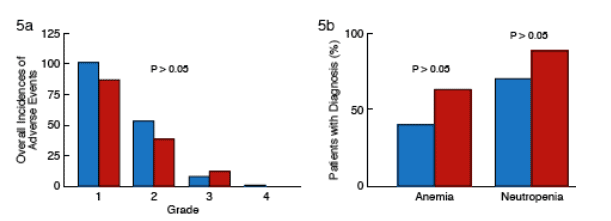
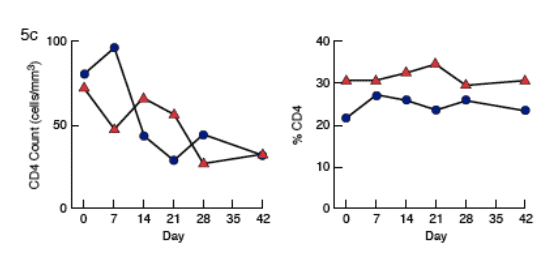
|
| |
|
 |
 |
|
|